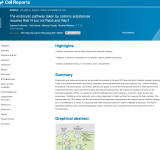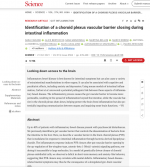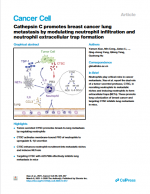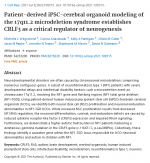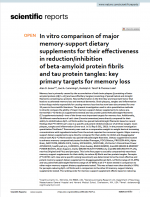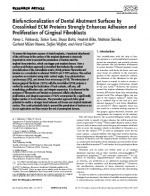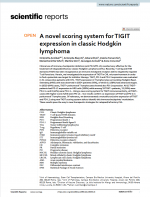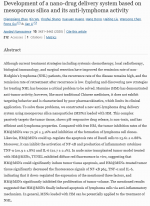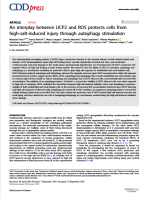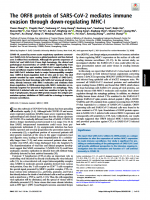10.12.2021
The endocytic pathway taken by cationic substances requires Rab14 but... Cell Reports, 2021
Abstract Endocytosis and endosome dynamics are controlled by proteins of the small GTPase Rab family. Besides possible recycling routes to the plasma membrane and various organelles, previously described endocytic pathways (e.g., clathrin-mediated endocytosis, macropinocytosis, CLIC/GEEC pathway) all appear to funnel the endocytosed material to Rab5-positive early endosomes that then mature into Rab7-positive late endosomes/lysosomes. By studying the uptake of a series of cell-penetrating peptides (CPPs), we identify an endocytic pathway t...
10.12.2021
Identification of a choroid plexus vascular barrier closing during int... Science, 2021
Abstract Up to 40% of patients with inflammatory bowel disease present with psychosocial disturbances. We previously identified a gut vascular barrier that controls the dissemination of bacteria from the intestine to the liver. Here, we describe a vascular barrier in the brain choroid plexus (PVB) that is modulated in response to intestinal inflammation through bacteria-derived lipopolysaccharide. The inflammatory response induces PVB closure after gut vascular barrier opening by the up-regulation of the wingless-type, cat...
03.12.2021
Cathepsin C promotes breast cancer lung metastasis by modulating neutr... Cancer Cell, 2021
Abstract Lung metastasis is the major cause of breast cancer-related mortality. The neutrophil-associated inflammatory microenvironment aids tumor cells in metastatic colonization in lungs. Here, we show that tumor-secreted protease cathepsin C (CTSC) promotes breast-to-lung metastasis by regulating recruitment of neutrophils and formation of neutrophil extracellular traps (NETs). CTSC enzymatically activates neutrophil membrane-bound proteinase 3 (PR3) to facilitate interleukin-1β (IL-1β) processing and nuclear factor κB a...
26.11.2021
Patient-derived iPSC-cerebral organoid modeling of the 17q11.2 microde... Patient-derived iPSC-cerebral organoid modeling of the 17q11.2 microde...
Abstract Neurodevelopmental disorders are often caused by chromosomal microdeletions comprising numerous contiguous genes. A subset of neurofibromatosis type 1 (NF1) patients with severe developmental delays and intellectual disability harbors such a microdeletion event on chromosome 17q11.2, involving the NF1 gene and flanking regions (NF1 total gene deletion [NF1-TGD]). Using patient-derived human induced pluripotent stem cell (hiPSC)-forebrain cerebral organoids (hCOs), we identify both neural stem cell (NSC) proliferation and neuronal...
19.11.2021
In vitro comparison of major memory-support dietary supplements for th... In vitro comparison of major memory-support dietary supplements for th...
Abstract Memory loss is primarily caused by the accumulation of both brain plaques [(consisting of beta-amyloid protein (Aβ) 1–42)] and neurofibrillary tangles (consisting of paired helical and straight filaments containing tau protein). Neuroinflammation is the third key and important factor that leads to accelerated memory loss and eventual dementia. Brain plaques, tangles and inflammation is the trilogy mainly responsible for causing memory loss that has now been documented for over 20 years in the scientific literature....
05.11.2021
Biofunctionalization of Dental Abutment Surfaces by Crosslinked ECM Pr... Advanced Healthcare Material, 2021
Abstract To ensure the long-term success of dental implants, a functional attachment of the soft tissue to the surface of the implant abutment is decisively important in order to prevent the penetration of bacteria into the implant-bone interface, which can trigger peri-implant disease. Here a surface modification approach is described that includes the covalent immobilization of the extracellular matrix (ECM) proteins fibronectin and laminin via a crosslinker to silanized Ti6Al4V and Y-TZP surfaces. The surface properties are evaluated us...
29.10.2021
TIGIT immunohistochemistry established a novel scoring system in class... Nature, scientific reports, 2021
Immune checkpoint inhibition of the PD1/PD-L1 pathway has revolutionized cancer therapy. Recent experiments demonstrate that combination therapies that target new checkpoints like TIGIT are more effective than classical PD1/PD-L1 monotherapies. Over the last two years, TIGIT has attracted the attention from pharmaceutical companies worldwide: TIGIT turned out to be the most attractive target from a so called „second wave of checkpoint modulators“. Consequently, a future challenge is to determine which patients are most suitable to receive...
22.10.2021
Development of a nano-drug delivery system based on mesoporous silica... Applied Nanoscience, 2020
Abstract Although current treatment strategies including systemic chemotherapy, local radiotherapy, biological immunology, and surgical resection have improved the remission rate of non-Hodgkin’s lymphoma (NHL) patients, the recurrence rate of the disease remains high, and the remission rate of retreatment after recurrence is low. Exploring and discovering new strategies for treating NHL has become a critical problem to be solved. Harmine (HM) has demonstrated anti-tumor activity; however, like most traditional Chinese medicines, it...
15.10.2021
An interplay between UCP2 and ROS protects cells from high-salt-induce... Cell Death and Disease, 2021
Abstract The mitochondrial uncoupling protein 2 (UCP2) plays a protective function in the vascular disease of both animal models and humans. UCP2 downregulation upon high-salt feeding favors vascular dysfunction in knock-out mice, and accelerates cerebrovascular and renal damage in the stroke-prone spontaneously hypertensive rat. Overexpression of UCP2 counteracts the negative effects of high-salt feeding in both animal models. We tested in vitro the ability of UCP2 to stimulate autophagy and mitophagy as a mechanism mediating its protecti...
08.10.2021
The ORF8 protein of SARS-CoV-2 mediates immune evasion through down-re... PNAS, 2021
COVID-19, caused by severe acute respiratory syndrome coronavirus 2 (SARS-CoV-2), has become a global pandemic and has claimed over 2 million lives worldwide. Although the genetic sequences of SARS-CoV and SARS-CoV-2 have high homology, the clinical and pathological characteristics of COVID-19 differ significantly from those of SARS. How and whether SARS-CoV-2 evades (cellular) immune surveillance requires further elucidation. In this study, we show that SARS-CoV-2 infection leads to major histocompability complex class Ι (MHC-Ι) down-regula...



